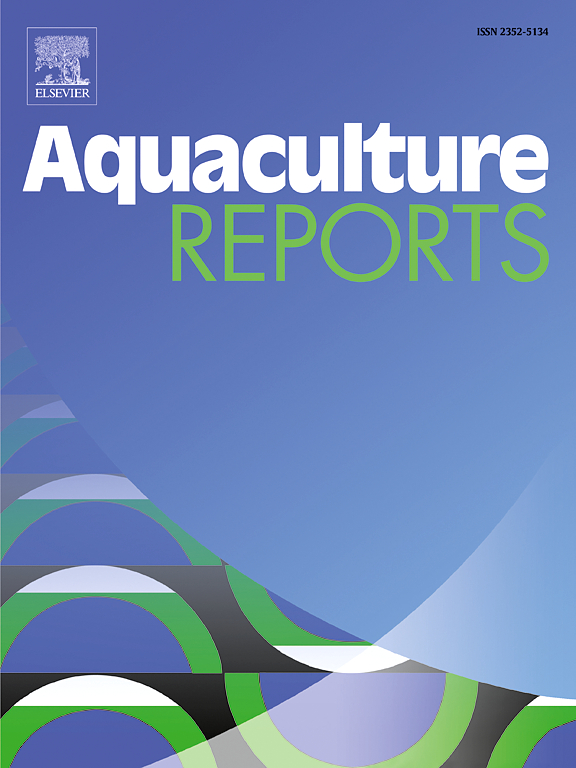Crowding causes detachment and loss of mobile sea lice: Fine-meshed crowding nets may mitigate spread
IF 3.2
2区 农林科学
Q1 FISHERIES
引用次数: 0
Abstract
Detachment of mobile lice from salmon during crowding and handling procedures in sea-cage fish farms may lead to loss and unwanted spread of ectoparasitic sea lice to other cages, farms or wild fish. However, rates of detachment and loss of lice during crowding are not well understood. We conducted a series of replicate crowding events in 125–2000 m3 sea-cages, using either a standard coarse-meshed crowding net, or a more fine-meshed crowding net intended to retain detached mobile lice. Lice that were detached during crowding and passed through the crowding net were collected using a 350-µm plankton net positioned around the crowding net (in some cases pumps and filters were also used), allowing lice ‘lost’ from the crowding net to be directly quantified. Detachment of lice during crowding varied from 2 % to 38 %, with higher detachment rates for smaller life stages (highest for pre-adult 1 salmon lice) and in trials involving larger fish and/or longer crowding durations (up to 2 h). In most cases, the type of crowding net did not affect detachment rates, but the fine-meshed crowding net did retain some detached lice, including 75 % of adult female salmon lice. The fine-meshed crowding net also improved welfare outcomes for crowded fish, including significantly reduced scale loss, fin damage and bleeding. Provided dissolved oxygen levels can be maintained, fine-meshed crowding nets may be the most promising means of limiting the spread of mobile lice into the surrounding environment, while also reducing injuries to fish. Supplementary benefits may be achieved by minimising crowding time but also ensuring filter collection on the water used to bring fish into wellboats and delousing systems.
拥挤会造成移动海虱的脱离和损失:细密的拥挤网可减少传播
在网箱养鱼场的拥挤和处理过程中,移动虱子会从鲑鱼身上脱落,这可能会导致外寄生性海虱丢失并意外传播到其他网箱、养殖场或野生鱼类。然而,人们对拥挤过程中虱子的脱落率和丢失率还不甚了解。我们在 125-2000 立方米的海网箱中进行了一系列重复的挤网活动,使用标准的粗目挤网或更细目的挤网,以保留脱落的移动虱子。在拥挤过程中脱落并通过拥挤网的虱子,用放置在拥挤网周围的 350 微米浮游生物网收集(在某些情况下也使用泵和过滤器),这样就可以直接量化从拥挤网 "丢失 "的虱子。挤网过程中虱子的脱落率从 2% 到 38% 不等,较小生命阶段的虱子脱落率较高(成鱼前 1 级大马哈鱼虱子脱落率最高),在涉及较大鱼类和/或较长挤网时间(长达 2 小时)的试验中,虱子脱落率也较高。在大多数情况下,挤网的类型不会影响虱子的脱落率,但细目挤网确实保留了一些脱落的虱子,包括 75% 的成年雌性大马哈鱼虱子。细目拥挤网还改善了拥挤鱼的福利状况,包括显著减少鳞片脱落、鳍损伤和出血。如果能保持溶氧水平,细目密集网可能是限制移动虱子向周围环境扩散的最有前途的方法,同时还能减少对鱼类的伤害。最大限度地缩短挤网时间,同时确保过滤收集将鱼带入井船和脱水系统的水,也可实现补充效益。
本文章由计算机程序翻译,如有差异,请以英文原文为准。
求助全文
约1分钟内获得全文
求助全文
来源期刊

Aquaculture Reports
Agricultural and Biological Sciences-Animal Science and Zoology
CiteScore
5.90
自引率
8.10%
发文量
469
审稿时长
77 days
期刊介绍:
Aquaculture Reports will publish original research papers and reviews documenting outstanding science with a regional context and focus, answering the need for high quality information on novel species, systems and regions in emerging areas of aquaculture research and development, such as integrated multi-trophic aquaculture, urban aquaculture, ornamental, unfed aquaculture, offshore aquaculture and others. Papers having industry research as priority and encompassing product development research or current industry practice are encouraged.
 求助内容:
求助内容: 应助结果提醒方式:
应助结果提醒方式:


